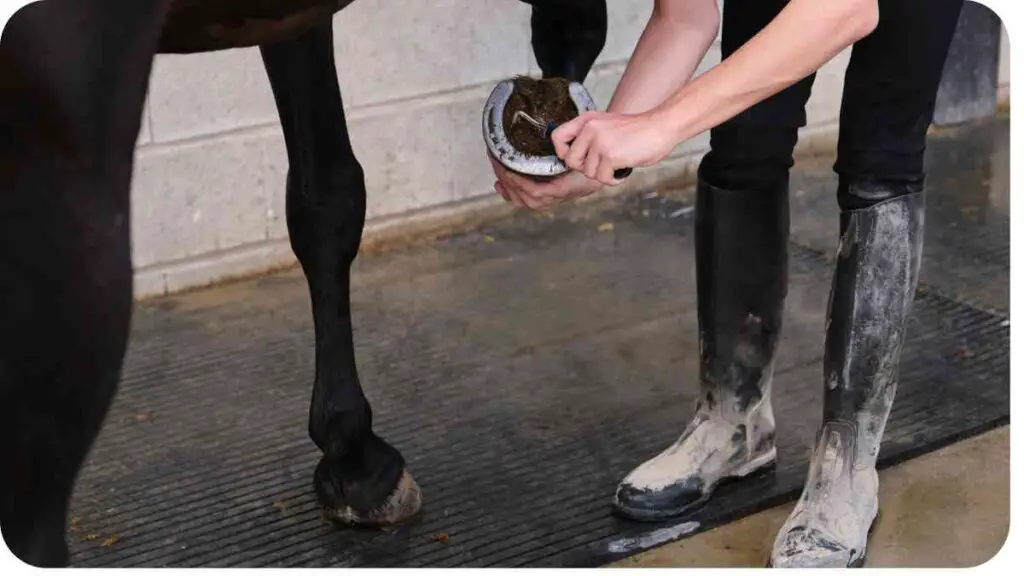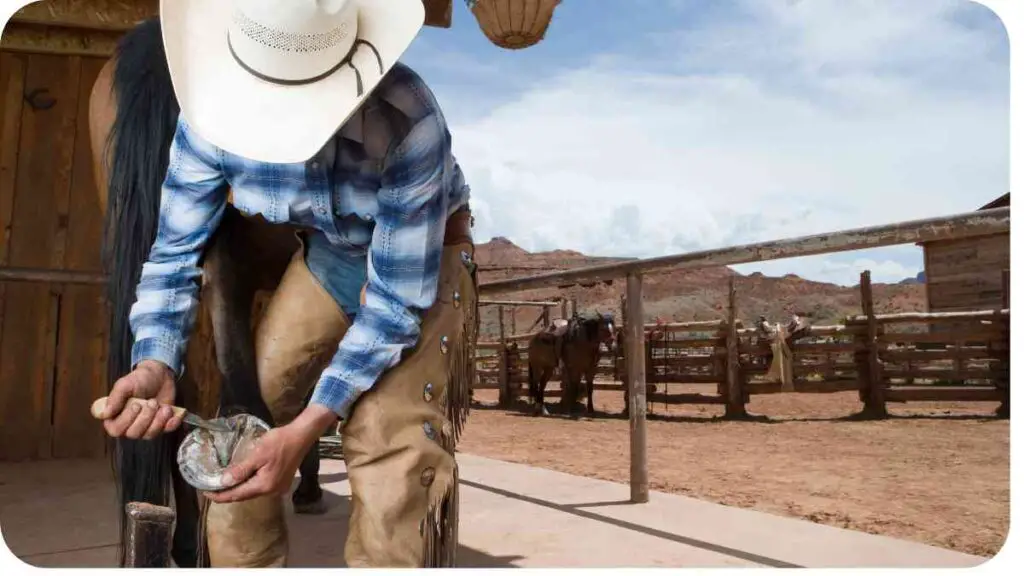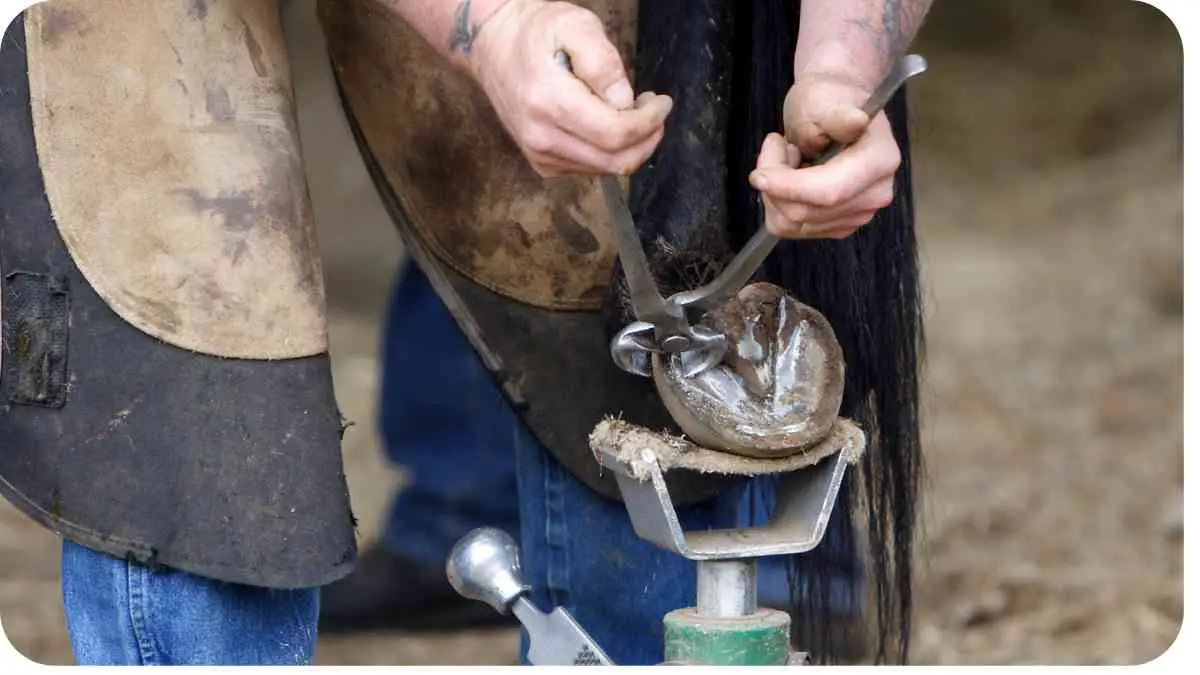As a horse owner, ensuring the well-being of your equine companion is of utmost importance. One crucial aspect often overlooked is hoof protection. In this comprehensive guide, we will delve into the world of rubber shoes as an alternative for horse hoof protection.
From understanding common hoof issues to exploring the advantages of rubber shoes, we’ll cover it all.
| Takeaways |
|---|
| Rubber shoes offer a modern alternative for horse hoof protection. |
| Understanding common hoof issues is essential for responsible horse ownership. |
| Rubber shoes provide advantages such as shock absorption and enhanced traction. |
| Expert insights and real-life success stories emphasize the positive impact of rubber shoes. |
| Proper maintenance and monitoring contribute to the longevity and effectiveness of rubber shoes. |
| Cost considerations, including a comparison with traditional methods, aid in decision-making. |
| Debunking myths surrounding rubber shoes ensures accurate information for horse owners. |
| Consultation with experts is recommended for horses with pre-existing hoof issues. |
2. Understanding the Importance of Hoof Protection
The horse’s hoof is a complex structure that plays a pivotal role in its overall health and functionality. Neglecting hoof care can lead to various issues, affecting the horse’s mobility and comfort. In this section, we’ll highlight why prioritizing hoof protection is crucial for every responsible horse owner.
Proper hoof care is paramount to a horse’s well-being. Regular maintenance, as discussed in Hoof Care 101, ensures healthy and resilient hooves, contributing to overall equine health.
3. Common Hoof Issues in Horses

Horses can suffer from various hoof problems, each requiring specific attention and care. We’ll discuss prevalent issues such as thrush, laminitis, abscesses, and hoof cracks, shedding light on their causes and potential consequences.
3.1 Thrush
Thrush is a common bacterial infection that affects the frog of the hoof. It thrives in moist and dirty conditions, potentially causing discomfort and lameness in horses.
3.2 Laminitis
Laminitis is the inflammation of the laminae, the sensitive tissues within the hoof. It can lead to severe pain and, if left untreated, may result in permanent damage.
Understanding the risks of bare hooves is essential for horse owners. Explore the insights in The Risks of Bare Hooves to make informed decisions on hoof protection and horse well-being.
3.3 Abscesses
Hoof abscesses are localized infections that can cause sudden and severe lameness. Identifying and addressing abscesses promptly is crucial for the horse’s well-being.
3.4 Hoof Cracks
Hoof cracks can vary in severity, from superficial to deep. They pose a risk of further complications and may compromise the structural integrity of the hoof.
4. Traditional Hoof Protection Methods
Before delving into rubber shoes, let’s explore the conventional methods of hoof protection, including horseshoes and hoof boots. Understanding their pros and cons will provide valuable context for considering rubber shoes as a viable alternative.
Addressing the concern of whether shoeing hurts horses is crucial. Delve into the details presented in Does Shoeing Hurt? to gain a comprehensive understanding of maintaining optimal horse hoof health.
4.1 Horseshoes
Horseshoes have been a longstanding method of protecting horse hooves. They provide support and traction but also come with drawbacks such as limited shock absorption.
4.2 Hoof Boots
Hoof boots offer a flexible and temporary solution for hoof protection. However, their effectiveness can vary, and some horses may find them uncomfortable.
5. The Rise of Rubber Shoes
In recent years, rubber shoes have gained popularity as a modern and versatile alternative for hoof protection. Let’s explore the advantages they offer and discuss how to choose the right pair for your horse’s needs.
Donkeys’ hooves are naturally durable, and understanding why they don’t need shoes is valuable. Learn more in Donkeys’ Durable Hooves, exploring the unique aspects of donkey hoof care.
5.1 Advantages of Rubber Shoes
Rubber shoes provide a range of benefits, from superior shock absorption to enhanced traction. Understanding these advantages is crucial for making an informed decision for your horse’s hoof care.
5.2 Choosing the Right Rubber Shoes
Selecting the appropriate rubber shoes involves considering factors such as material, design, and fit. To simplify the decision-making process, refer to the table below for a comparison of different rubber shoe brands.
| Brand | Material | Design Features | Fit Options | Price Range |
|---|---|---|---|---|
| HoofWear | High-quality rubber | Vented sole for breathability | Regular, Wide | $50 – $80 |
| EquiFlex ProGuard | Durable polymer blend | Shock-absorbing technology | Regular, Narrow | $60 – $90 |
| Pegasus ComfortFit | Natural rubber | Anti-slip tread | Regular, Wide | $70 – $100 |
6. How Rubber Shoes Work for Hoof Protection
Understanding the mechanics behind rubber shoes is essential for appreciating their effectiveness. In this section, we’ll delve into how rubber shoes provide impact absorption, traction, and overall protection for your horse’s hooves.
6.1 Impact Absorption
Rubber shoes excel in absorbing shock and impact, reducing the strain on the horse’s joints and hooves. This feature is especially beneficial for horses engaged in various activities, from trail riding to competitive sports.
6.2 Traction and Grip
The anti-slip properties of rubber shoes enhance the horse’s stability, especially on uneven terrain. Whether navigating rocky trails or slippery surfaces, rubber shoes contribute to a secure and confident stride.
Knowing when to add horseshoes is a crucial decision for horse owners. Explore the considerations outlined in When the Shoe Fits to ensure optimal hoof protection and overall equine well-being.
7. Transitioning to Rubber Shoes
Switching from traditional hoof protection methods to rubber shoes requires careful consideration and a gradual transition. In this section, we’ll outline the training period, monitoring techniques, and common challenges faced during this process.
7.1 Training Period
Introduce rubber shoes gradually to allow your horse to acclimate. Start with short sessions and gradually increase the duration as your horse becomes comfortable.
7.2 Monitoring Hoof Health

Regularly inspect your horse’s hooves during the transition period. Look for any signs of discomfort, rubbing, or uneven wear. Adjust the fit if necessary to ensure optimal comfort.
7.3 Common Challenges and Solutions
| Challenge | Solution |
|---|---|
| Rubbing and Chafing | Adjust fit and consider using protective padding. |
| Reluctance to Move | Reevaluate fit and consult with a farrier if needed. |
| Uneven Wear Patterns | Monitor closely and address any fit issues promptly. |
8. Expert Insights: Interviews with Farriers and Veterinarians
To provide a deeper understanding of the benefits of rubber shoes, we reached out to experts in the field. Let’s hear from Dr. Sarah Johnson, a renowned veterinarian specializing in equine health, and Farrier Joe Rodriguez, with years of experience in hoof care.
8.1 Dr. Sarah Johnson on Hoof Health
Dr. Sarah Johnson emphasizes the importance of proactive hoof care. “Rubber shoes offer a balanced solution, providing protection without compromising the natural movement of the hoof. Regular check-ups and choosing the right shoes can significantly contribute to long-term hoof health.”
8.2 Farrier Joe Rodriguez’s Experience with Rubber Shoes
Farrier Joe Rodriguez shares his positive experiences with rubber shoes. “I’ve seen a notable decrease in hoof-related issues since recommending rubber shoes to my clients. The shock absorption and traction they provide make them a valuable asset in maintaining optimal hoof health.”
9. Real-Life Success Stories
Discovering how rubber shoes have positively impacted other horse owners can be motivating. Let’s explore a case study and hear testimonials from those who have experienced success with rubber shoes.
9.1 Case Study: Overcoming Chronic Hoof Issues with Rubber Shoes
Sarah’s horse, Charlie, suffered from chronic lameness due to hoof issues. After transitioning to rubber shoes, Charlie’s condition improved significantly. The shock-absorbing properties of the shoes played a crucial role in his recovery.
9.2 Testimonials from Horse Owners
- Mary R.: “Rubber shoes have been a game-changer for my trail rides. My horse, Daisy, moves with more confidence, and I’ve noticed a considerable reduction in hoof soreness.”
- John K.: “I was skeptical at first, but after witnessing the positive changes in my horse’s comfort and performance, I’m a firm believer in the benefits of rubber shoes.”
10. Tips for Maintaining Rubber Shoes
Ensuring the longevity and effectiveness of rubber shoes involves proper maintenance. Follow these tips to keep your horse’s footwear in optimal condition.
10.1 Cleaning and Inspection
Regularly clean the rubber shoes to remove debris and mud. Inspect for any signs of wear, tear, or damage. Prompt cleaning and maintenance contribute to the overall durability of the shoes.
10.2 Replacement Schedule
Monitor the wear patterns of the rubber shoes and adhere to a replacement schedule. Even durable materials can wear out over time, and timely replacement is crucial to maintaining effective hoof protection.
11. Cost Considerations: Are Rubber Shoes Worth It?
While rubber shoes offer numerous benefits, cost can be a significant factor for horse owners. Let’s compare the expenses associated with rubber shoes and traditional hoof protection methods.
11.1 Cost Comparison – Rubber Shoes vs. Traditional Hoof Protection
| Aspect | Rubber Shoes | Horseshoes | Hoof Boots |
|---|---|---|---|
| Initial Cost | Moderate to High | Low to Moderate | Moderate |
| Maintenance Cost | Low | Moderate to High | Moderate |
| Replacement Frequency | 6-12 months | 4-6 weeks | 3-6 months |
Understanding the long-term cost implications can aid in making an informed decision based on your budget and the specific needs of your horse.
12. Addressing Common Myths about Rubber Shoes

Misconceptions can deter horse owners from exploring new hoof protection methods. Let’s debunk common myths surrounding rubber shoes and provide accurate information.
12.1 Myth: Rubber Shoes Cause Hoof Weakness
Contrary to this myth, rubber shoes, when properly fitted and used, do not weaken hooves. In fact, the shock absorption they provide can contribute to overall hoof health.
12.2 Myth: Rubber Shoes Can’t Withstand Rough Terrain
Modern rubber shoes are designed to withstand various terrains. With durable materials and advanced technology, they offer reliable protection on trails, rocky surfaces, and even in challenging weather conditions.
13. Conclusion
In conclusion, rubber shoes have emerged as a viable and beneficial alternative for horse hoof protection. Their advantages, coupled with expert insights and real-life success stories, highlight the positive impact they can have on your horse’s well-being. By understanding the transition process, maintenance tips, and cost considerations, you can make an informed decision for the health and comfort of your equine companion.
15. Frequently Asked Questions (FAQs)
15.1 Are rubber shoes suitable for all horse breeds?
Yes, rubber shoes are designed to accommodate various horse breeds. However, selecting the right size and fit is crucial for optimal comfort and effectiveness.
15.2 Can rubber shoes be used for competitive events?
Many horse owners use rubber shoes for competitive events, especially those involving varied terrains. However, always check event regulations and guidelines to ensure compliance.
15.3 How often should rubber shoes be replaced?
The replacement frequency depends on factors such as the horse’s activity level and the terrain. Generally, replacement every 6-12 months is recommended, but regular inspections should guide the decision.
15.4 Are there specific considerations for horses with pre-existing hoof issues?
Further Reading
- Duval Horse Products – Rubberen Hoefijzers (Rubber Horseshoes)
- Explore Duval Horse Products for insights into rubber horseshoes for horses. Learn about their product offerings and the benefits they provide for hoof protection.
- Chronicle of the Horse Forum – Hoof Boots Over Shoes: Anybody Tried This?
- Engage in discussions on the Chronicle of the Horse Forum regarding the use of hoof boots over shoes. Gain valuable insights from fellow horse owners who have explored alternative hoof protection methods.
- Cavallo Inc. – Where the Rubber Meets the Road: Alternatives to Metal Horseshoes
- Delve into Cavallo Inc.’s article discussing alternatives to traditional metal horseshoes. Learn about the various options available and the advantages of choosing rubber-based alternatives.
FAQs
Are rubber shoes suitable for all horse breeds?
Yes, rubber shoes are designed to accommodate various horse breeds. However, selecting the right size and fit is crucial for optimal comfort and effectiveness.
Can rubber shoes be used for competitive events?
Many horse owners use rubber shoes for competitive events, especially those involving varied terrains. However, always check event regulations and guidelines to ensure compliance.
How often should rubber shoes be replaced?
The replacement frequency depends on factors such as the horse’s activity level and the terrain. Generally, replacement every 6-12 months is recommended, but regular inspections should guide the decision.
Are there specific considerations for horses with pre-existing hoof issues?
Consult with a veterinarian or farrier before transitioning horses with pre-existing hoof issues to rubber shoes. They can provide tailored advice based on the specific condition and needs of the horse.
Can rubber shoes be used in extreme weather conditions?
Yes, modern rubber shoes are designed to withstand various weather conditions, providing reliable protection even in challenging environments.

Hi there! My name is Hellen James, and I’m a horse riding expert. I’ve been riding horses since I was just a kid—and it’s been my passion ever since. But getting started with horse riding can be overwhelming. There’s so much to learn! If you’re looking for a way to get started and make sure you’re doing it right, I’m here to help.


